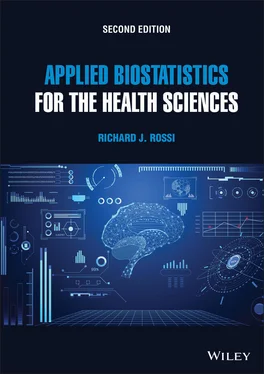Richard J. Rossi - Applied Biostatistics for the Health Sciences
Здесь есть возможность читать онлайн «Richard J. Rossi - Applied Biostatistics for the Health Sciences» — ознакомительный отрывок электронной книги совершенно бесплатно, а после прочтения отрывка купить полную версию. В некоторых случаях можно слушать аудио, скачать через торрент в формате fb2 и присутствует краткое содержание. Жанр: unrecognised, на английском языке. Описание произведения, (предисловие) а так же отзывы посетителей доступны на портале библиотеки ЛибКат.
- Название:Applied Biostatistics for the Health Sciences
- Автор:
- Жанр:
- Год:неизвестен
- ISBN:нет данных
- Рейтинг книги:3 / 5. Голосов: 1
-
Избранное:Добавить в избранное
- Отзывы:
-
Ваша оценка:
- 60
- 1
- 2
- 3
- 4
- 5
Applied Biostatistics for the Health Sciences: краткое содержание, описание и аннотация
Предлагаем к чтению аннотацию, описание, краткое содержание или предисловие (зависит от того, что написал сам автор книги «Applied Biostatistics for the Health Sciences»). Если вы не нашли необходимую информацию о книге — напишите в комментариях, мы постараемся отыскать её.
APPLIED BIOSTATISTICS FOR THE HEALTH SCIENCES Applied Biostatistics for the Health Sciences
Applied Biostatistics for the Health Sciences
Applied Biostatistics for the Health Sciences — читать онлайн ознакомительный отрывок
Ниже представлен текст книги, разбитый по страницам. Система сохранения места последней прочитанной страницы, позволяет с удобством читать онлайн бесплатно книгу «Applied Biostatistics for the Health Sciences», без необходимости каждый раз заново искать на чём Вы остановились. Поставьте закладку, и сможете в любой момент перейти на страницу, на которой закончили чтение.
Интервал:
Закладка:
1.2.1 The Basic Biostatistical Terminology
In developing the statistical protocol to be used in a research study, biostatisticians use the basic terminology listed below.
The target population is the population that is being studied in the research project.
The units of a target population are the objects on which the measurements will be taken. When the units of the population are human beings, they are referred to as subjects or individuals.
A subpopulation of the target population is a well-defined subset of the population units.
A parameter is a numerical measure of a characteristic of the target population.
A sample is a subset of the target population units. A census is sample consisting of the entire set of population units.
The sample size is the number of units observed in the sample.
A random sample is a sample that is chosen according to a sampling plan where the probability of each possible sample that can be drawn from the target population is known.
A statistic is any value that is computed using only the sample observations and known values.
A cohort is a group of subjects having similar characteristics.
A variable is a characteristic that will be recorded or measured on a unit in the target population.
A response variable or outcome variable is the variable in a research study that is of primary interest or the variable that is being modeled. The response variable is also sometimes called the dependent variable.
An explanatory variable is a variable that is used to explain or is believed to cause changes in the response variable. The explanatory variables are also called independent variables or predictor variables.
A treatment is any experimental condition that is applied to the units.
A placebo is an inert or inactive treatment that is applied to the units.
A statistical inference is an estimate, conclusion, or generalization made about the target population from the information contained in an observed sample.
A statistical model is a mathematical formula that relates the response variable to the explanatory variables.
One of the most misunderstood and abused concepts in statistics is the difference between a parameter and a statistic, and researchers who do not have a basic understanding of statistics often use these terms interchangeably, which is incorrect. Whether a number is a parameter or a statistic is determined by asking whether or not the number was computed from the entire set of units in the target population (parameter) or from a sample of the units in the target population (statistic). It is important to distinguish whether a number is a parameter or a statistic because a parameter will provide the answer to a statistical research question, while a statistic can provide information only regarding the answer, and there is a degree of uncertainty associated with the information contained in a statistic.
Example 1.1
In a study designed to determine the percentage of obese adults in the United States, the BMI of 500 adults was measured at several hospitals across the country. The resulting percentage of the 500 adults classified as obese was 24%.
In this study, the target population was adults in the United States, 500 adults constitute a sample of the adults in the United States, the parameter of interest is the percentage of obese adults in the United States, and 24% is a statistic since it was computed from the sample, not the target population.
In designing a biomedical research study, the statistical protocol used in the study is usually determined by the research team in conjunction with the biostatistician. The statistical protocol should include the identification of the target population, the units in the population, the response variable and explanatory variables, the parameters of interest, the treatments or subpopulations being studied, the sample size, and models that will be fit to the observed data.
Example 1.2
In a study investigating the average survival time for stage IV melanoma patients receiving two different doses of interferon, n = 150 patients will be monitored. The age, sex, race, and tumor thickness of each patient will be recorded along with the time they survived after being diagnosed with stage IV melanoma. For this study, determine the following components of the statistical protocol:
1 a. the target population,
2 b. the units of target population,
3 c. the response variable,
4 d. the explanatory variables,
5 e. the parameter of interest,
6 f. the treatments,
7 g. the sample size.
Solutions
1 a. The target population in this study is individuals diagnosed with stage IV melanoma.
2 b. Units of the target population are the individuals diagnosed with stage IV melanoma.
3 c. The response variable in this study is the survival time after diagnosis with stage IV melanoma.
4 d. Explanatory variables in this study are age, sex, race, and tumor thickness.
5 e. The parameter of interest in this study is the average survival time after diagnosis with stage IV melanoma.
6 f. Treatments are the two different doses of interferon.
7 g. The sample size is n = 150.
1.2.2 Biomedical Studies
There are many different research protocols that are used in biomedical studies. Some protocols are forward looking studying what will happen in the future, some look at what has already occurred, and some are based on a cohort of subjects having similar characteristics. For example, the Framingham Heart Study is a large study conducted by the National Heart, Lung, and Blood Institute (NHLBI) that began in 1948 and continues today. The original goal of the Framingham Heart Study was to study the general causes of heart disease and stroke, and the three cohorts that have or are currently being studied in the Framingham Heart Study are as follows.
1 the original cohort that consists of a group of 5209 men and women between the ages of 30 and 62 recruited from Framingham, Massachusetts.
2 The second cohort, called the Offspring Cohort, consists of 5124 of the original participants’ adult children and their spouses.
3 the third cohort that consists of children of the Offspring Cohort. The third cohort is recruited with a planned target study size of 3500 grandchildren from members of the original cohort.
Two other large ongoing biomedical studies are the Women’s Health Initiative (WHI), which is a research study focusing on the health of women, and the National Health and Nutrition Examination Survey (NHANES), which is designed to assess the health and nutritional status of adults and children in the United States.
Several of the commonly used biomedical research protocols are described below.
A cohort study is a research study carried out on a cohort of subjects. Cohort studies often involve studying the patients over a specified time period.
A prospective study is a research study where the subjects are enrolled in the study and then followed forward over a period of time. In a prospective study, the outcome of interest has not yet occurred when the subjects are enrolled in the study.
A retrospective study is a research study that looks backward in time. In a retrospective study, the outcome of interest has already occurred when the subjects are enrolled in the study.
A case–control study is a research study in which subjects having a certain disease (cases) are compared with subjects who do not have the disease (controls).
A longitudinal study is a research study where the same subjects are observed over an extended period of time.
A cross-sectional study is a study to investigate the relationship between a response variable and the explanatory variables in a target population at a particular point in time.
Читать дальшеИнтервал:
Закладка:
Похожие книги на «Applied Biostatistics for the Health Sciences»
Представляем Вашему вниманию похожие книги на «Applied Biostatistics for the Health Sciences» списком для выбора. Мы отобрали схожую по названию и смыслу литературу в надежде предоставить читателям больше вариантов отыскать новые, интересные, ещё непрочитанные произведения.
Обсуждение, отзывы о книге «Applied Biostatistics for the Health Sciences» и просто собственные мнения читателей. Оставьте ваши комментарии, напишите, что Вы думаете о произведении, его смысле или главных героях. Укажите что конкретно понравилось, а что нет, и почему Вы так считаете.












